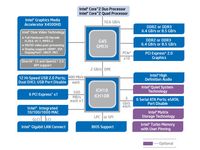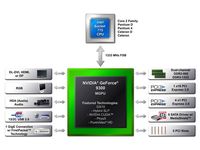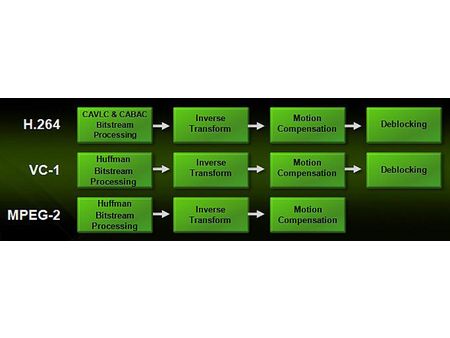Move Over G45: Nvidia's GeForce 9300 Arrives
Out Of The Chipset Business? Not Yet, At Least
Nvidia’s new GeForce 9300 would appear to go toe to toe with Intel’s G45 from a raw specifications standpoint. Both platforms support Core 2 Duos and Quads with front side bus speeds of up to 1,333 MHz. The two chipsets also support DDR2 and DDR3 memory. And while Nvidia’s offering goes a step further by accommodating DDR3-1333 (compared to Intel’s 1,066 MHz ceiling), we have to imagine that most motherboard vendors are going to continue snubbing DDR3 on their entry-level models (indeed, Nvidia confirms that all of the launch boards employ DDR2). Intel and Nvidia both support DirectX 10 through their integrated graphics cores. Likewise, they also support VGA, DVI, HDMI, and DisplayPort outputs. But from there, the onboard graphics engines diverge.
GeForce 9300 Graphics
The GeForce 9300, which Nvidia says is equivalent to the G86 architecture powering its GeForce 8400 GS discrete card, features 16 unified shader processors running at 1,200 MHz. Intel’s G45 boasts 10 shaders running at 800 MHz. Not only does Nvidia wield the advantage in onboard graphics resources, but also clock speed. According to Nvidia, the difference translates to several times the performance of Intel’s solution. But with a benchmark set so low, we’re still wondering if the GeForce 9300 can deliver playable frame rates.
More certain is the 9300’s ability to serve up smooth video playback through its integrated PureVideo HD video processor, which Nvidia claims is able to offload 100% of movie playback in H.264, VC1, and MPEG-2 formats. This doesn’t mean you’ll realize 0% host processor utilization though, as we’ll see in the benchmarks.
The 65nm mGPU also includes support for Nvidia’s PhysX and CUDA technologies, which will be of limited use to most folks. There is actually a fairly substantial list of titles with PhysX support—it’s just that we’ve never really felt compelled to try out Magic Ball 3 or Ultra Tubes before. Higher-profile offerings include Unreal Tournament 3 and Mass Effect. Similarly, the list of CUDA-enabled applications is also growing. But most of them are purpose-built titles written to handle molecular dynamics, computational chemistry, and holographic microscopy. The more notable mainstream applications include Elemental’s Badaboom media converter and Adobe’s upcoming Photoshop CS4. The Adobe app isn’t available yet, but Will Smith of Maximum PC has an interesting comparison online of Badaboom versus Handbrake 0.9.2 suggestion that while the technology is promising, it’s not quite all the way there yet with regard to quality, even if it does introduce substantial performance gains.
More Chipset Details
Back to the similarities. GeForce 9300 and G45 both include individual PCI Express x16 slots compliant with the 2.0 specification. On G45, you’d use that slot as a reprieve from the anemic integrated core, replacing it completely with a discrete board. GeForce 9300 gives you two options: either populate the slot with a high-end card and shut off the integrated core altogether, or add a discrete GeForce 8400 GS/GeForce 8500 GT card to enable GeForce Boost. We’ve covered the basic functionality of GeForce Boost already. In short, it works similarly to SLI, leveraging the mGPU and a discrete GPU cooperatively. Of course, the 790GX board in this comparison goes a step further, enabling true CrossFire support through a pair of x16 PCI Express 2.0 slots wired to run in a x8 mode when they’re both populated.
Get Tom's Hardware's best news and in-depth reviews, straight to your inbox.
For the rest of G45’s base functionality, you have to move away from the Intel’s memory controller hub and down to its ICH10 controller—the southbridge in any other language. A 2 GB/s interface connects the two components. Although it’s loaded down with 12 USB 2.0 ports offering 480 Mb/s of throughput each, six PCI Express x1 slots able to move 500 MB/s apiece, Gigabit Ethernet, six SATA 3 Gb/s ports, and a High Definition Audio controller, Intel apparently doesn’t see there being any issues with bandwidth.
Nvidia circumvents that challenge altogether by using a single-chip design. The same component hosting the GeForce 9300 graphics and memory controller also delivers four PCI Express x1 slots (2.0 versus Intel’s 1.1), six SATA ports, Gigabit Ethernet, 12 USB 1.0 ports 7.1-channel LPCM HD Audio, and five standard PCI slots. As with Intel, Nvidia’s storage subsystem supports RAID 0, 1, 0+1, and 5 arrays, too.
Current page: Out Of The Chipset Business? Not Yet, At Least
Prev Page Introduction Next Page MSI’s P7NGM-Digital Motherboard-
Ryun Good article but I feel compelled to say that I don't understand your choice for pitting the 790GX (~$140 board) and a 5400+ (~$80) with an the E7200 (~$120) and the G45 (~$100).Reply
Wouldn't it have made more sense to pair up similarly priced components, such as the 780g and 5400+ vs a E2180 and G45? Maybe someone could explain the reasoning? -
ricstorms I think a better Intel processor for an apt comparison should have been the E5200, which is only about $10 more expensive than the 5400+. Also, no mention was made that the 790GX platform is much more versatile, thanks to its 2 PCIExpress x16 slots (albeit running in x8 mode in Crossfire). Also, I would have liked to see the overclocking results with all three platforms, that is one of the strengths of the 790GX platform. (since AMD processors have fallen from grace, its almost impossible to find good reviews, I didn't see one in a google search for the 5400+ black edition)Reply
I think that the 780g platform is more analogous to the 9300. I would have liked to seen either a 8650 or a 6000+ competing on that than a 5400 on the 790GX, many of its features are not being used here. That being said I still think the Nvidia/Intel platform would fair better. It seems to me that this article is at some points aimed at gamers and at other home theater enthusiasts. I think the article would have been better suited focusing on either one, not both. -
chaohsiangchen I agree with Ryun about the price comparison.Reply
Cheapest G45 board is around $109 from Intel (discarding ECS) on newegg. G31 is outdated.
$100 730i board would be pitted against G45 board directly.
780G boards are slightly cheaper and still more capable then NVIDIA MCP7x and any Intel IGP solution. JetWay is offering JetWay HA07 790GX/SB750 board for $90 on newegg at the moment.
-
Reynod I still don't understand how you can say the AMD system draws less power at idle then declare the Intel system to be the winner i nthe power stakes??Reply
Can you please explain that one?
I would hardly put a 5400+ in a HTPC either ... I'd throw in a low power dual core ... bet that would make mincemeat out of the Intel systems and still give quality playback and much smoother graphics up on the screen.
Plus we all know the NVidia Graphics chips in this iteration are defective ... why buy a defective mobo to begin with?
It might not last very long.
Doesn't make good purchasing sense.
Even Apple are publicly stating that all current GPU's have defective substrates causing bonding issue, reducing the lifeltime of the GPU largely based on thermals I guess.
The E7200 is a good performer ... very good in fact. -
Liuqyn if they had done that, then they would have had to admit that AMD was still the better value for entry level gaming and HTPC use.Reply -
marees I agree perfrectly with Ryun that you cant compare e7200 with ath 5400.Reply
I would like to add that a phenom (8450?/9550?) processor should have been used because of the higher hyper transport speed advantages and also to check if the power consumtion is different.
Hopefully TomsHarware will update the figures including scores for phenom processor and also nvidia 8200/8300 chipsets for amd processors, just for completeness sake. -
chaohsiangchen ReynodPlus we all know the NVidia Graphics chips in this iteration are defective ... why buy a defective mobo to begin with?It might not last very long.Reply
Not true. Don't believe anything comes out from Charlie Demerjian until proven. -
Shadow703793 Well written! Next time do you mind posting a bit on if the board is capable of OCing a bit?Reply -
cangelini ryunGood article but I feel compelled to say that I don't understand your choice for pitting the 790GX (~$140 board) and a 5400+ (~$80) with an the E7200 (~$120) and the G45 (~$100).Wouldn't it have made more sense to pair up similarly priced components, such as the 780g and 5400+ vs a E2180 and G45? Maybe someone could explain the reasoning?Reply
Ryun,
The Intel- and AMD-based platforms both add up to $220. Assuming all other components are the same (memory, HDD, PSU, etc), you end up with two machines that cost the same amount of money. -
cangelini ricstormsI think a better Intel processor for an apt comparison should have been the E5200, which is only about $10 more expensive than the 5400+. Also, no mention was made that the 790GX platform is much more versatile, thanks to its 2 PCIExpress x16 slots (albeit running in x8 mode in Crossfire). Also, I would have liked to see the overclocking results with all three platforms, that is one of the strengths of the 790GX platform. (since AMD processors have fallen from grace, its almost impossible to find good reviews, I didn't see one in a google search for the 5400+ black edition) I think that the 780g platform is more analogous to the 9300. I would have liked to seen either a 8650 or a 6000+ competing on that than a 5400 on the 790GX, many of its features are not being used here. That being said I still think the Nvidia/Intel platform would fair better. It seems to me that this article is at some points aimed at gamers and at other home theater enthusiasts. I think the article would have been better suited focusing on either one, not both.Reply
Hi Rick!
You're right on the money about the 790GX's support for CrossFire. I'll look for a place in the piece to add mention of that. The 790GX chipset isn't going to add anything to overclocking in this particular comparison, though, since it's not a Phenom in the socket, but an Athlon 64 X2.
I believe this platform is best suited to an HTPC crowd, but I couldn't ignore Nvidia's insistence that gaming is good here as well. And to that end, I'd still recommend an add-in board under $100 like AMD's Radeon HD 4670.



